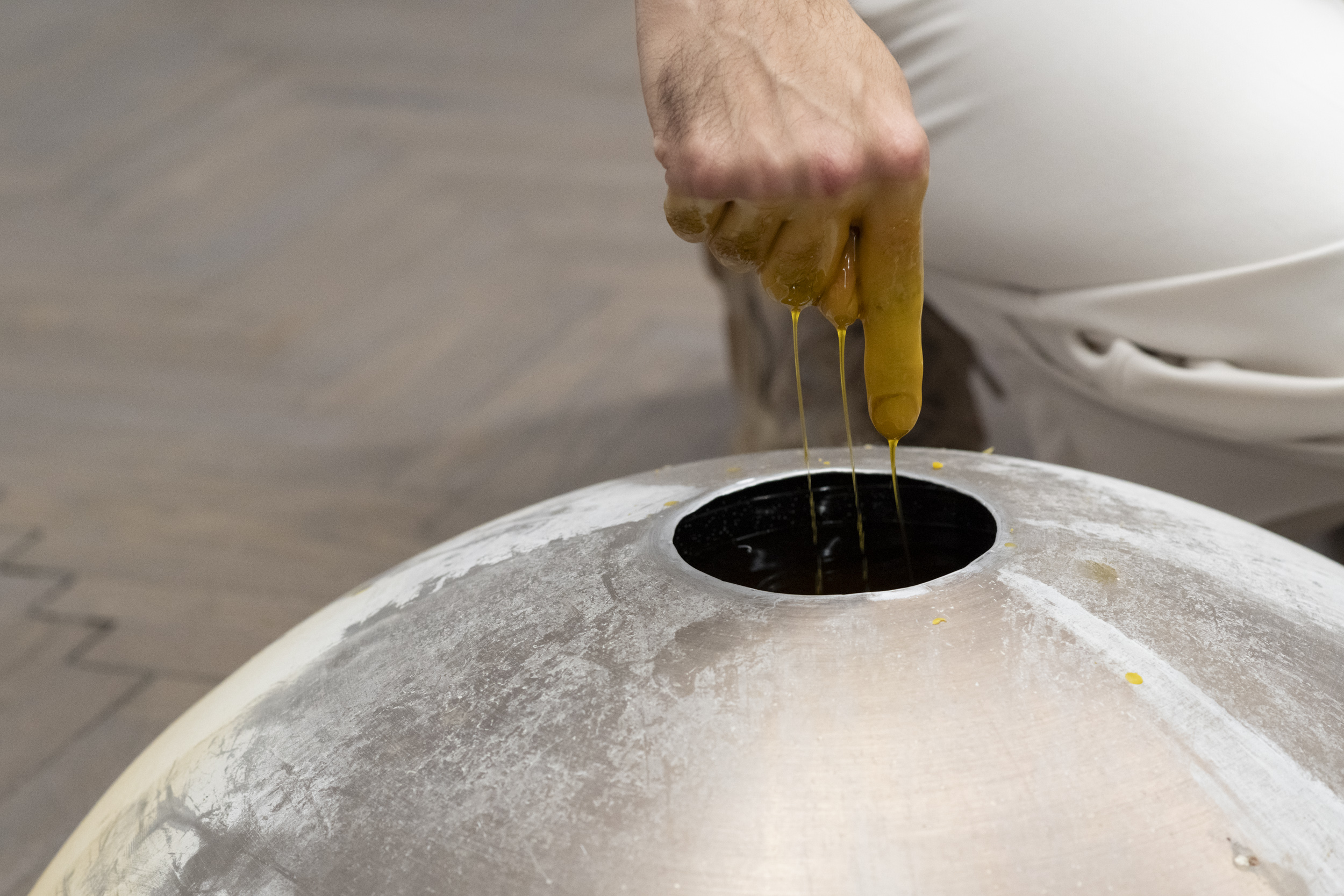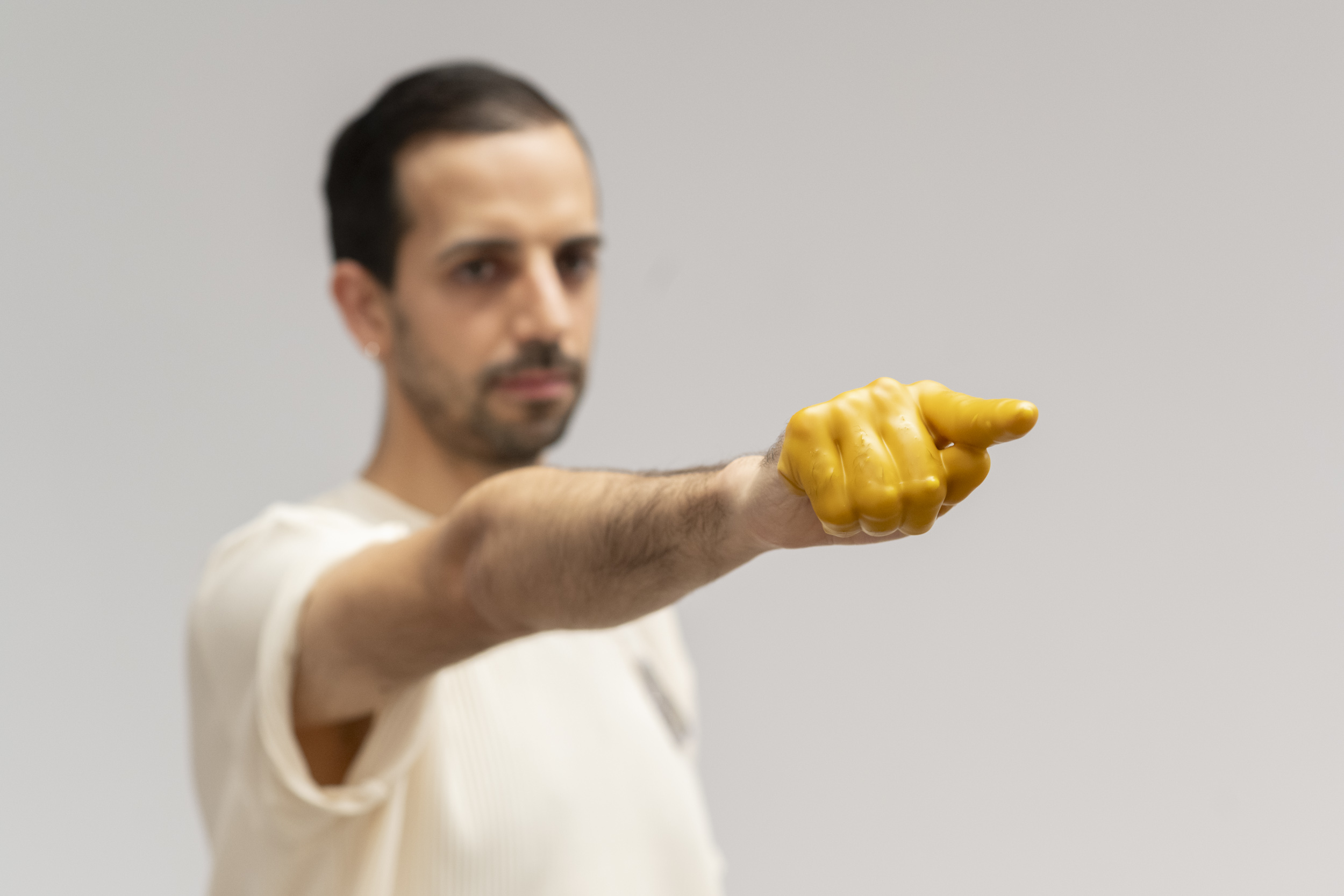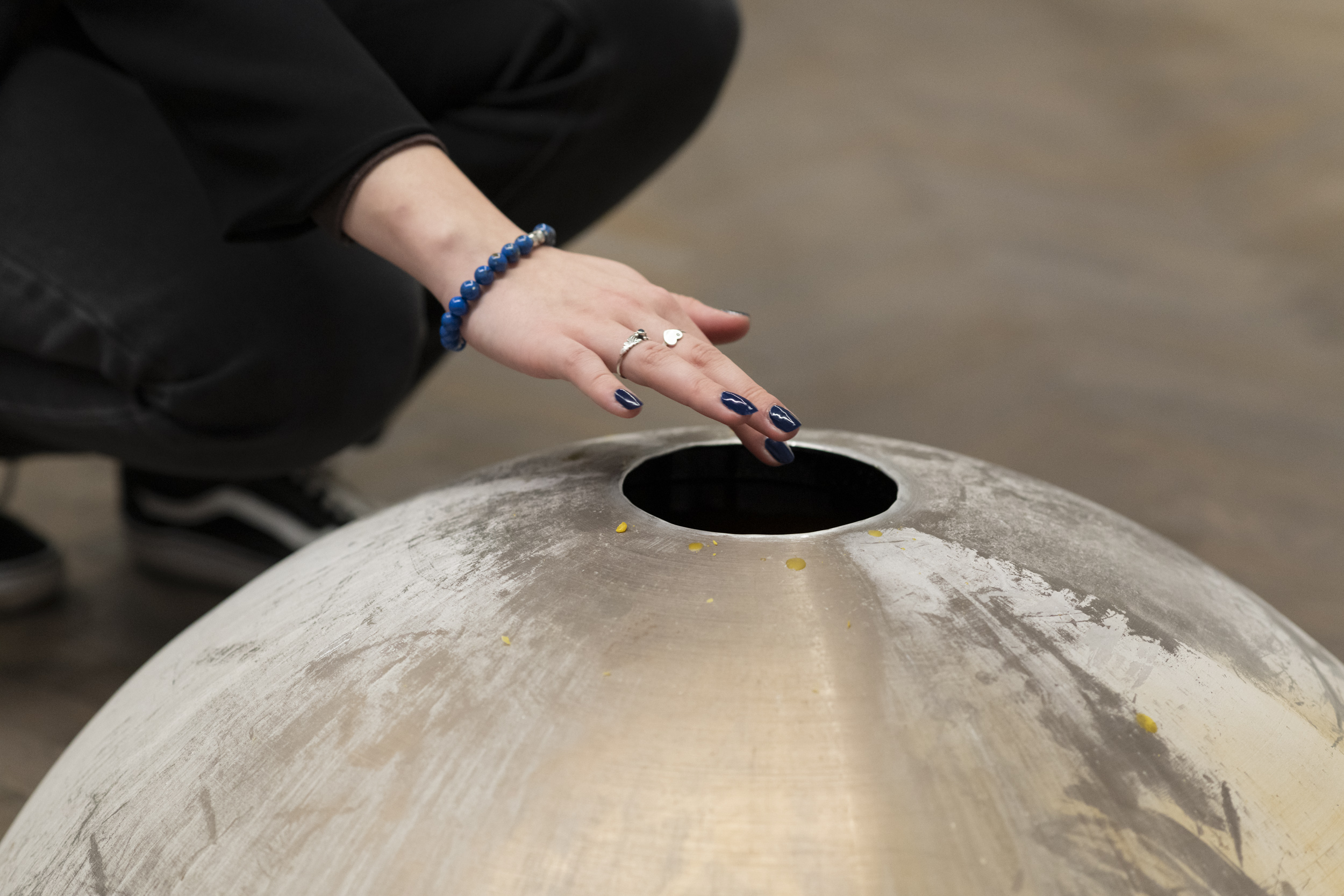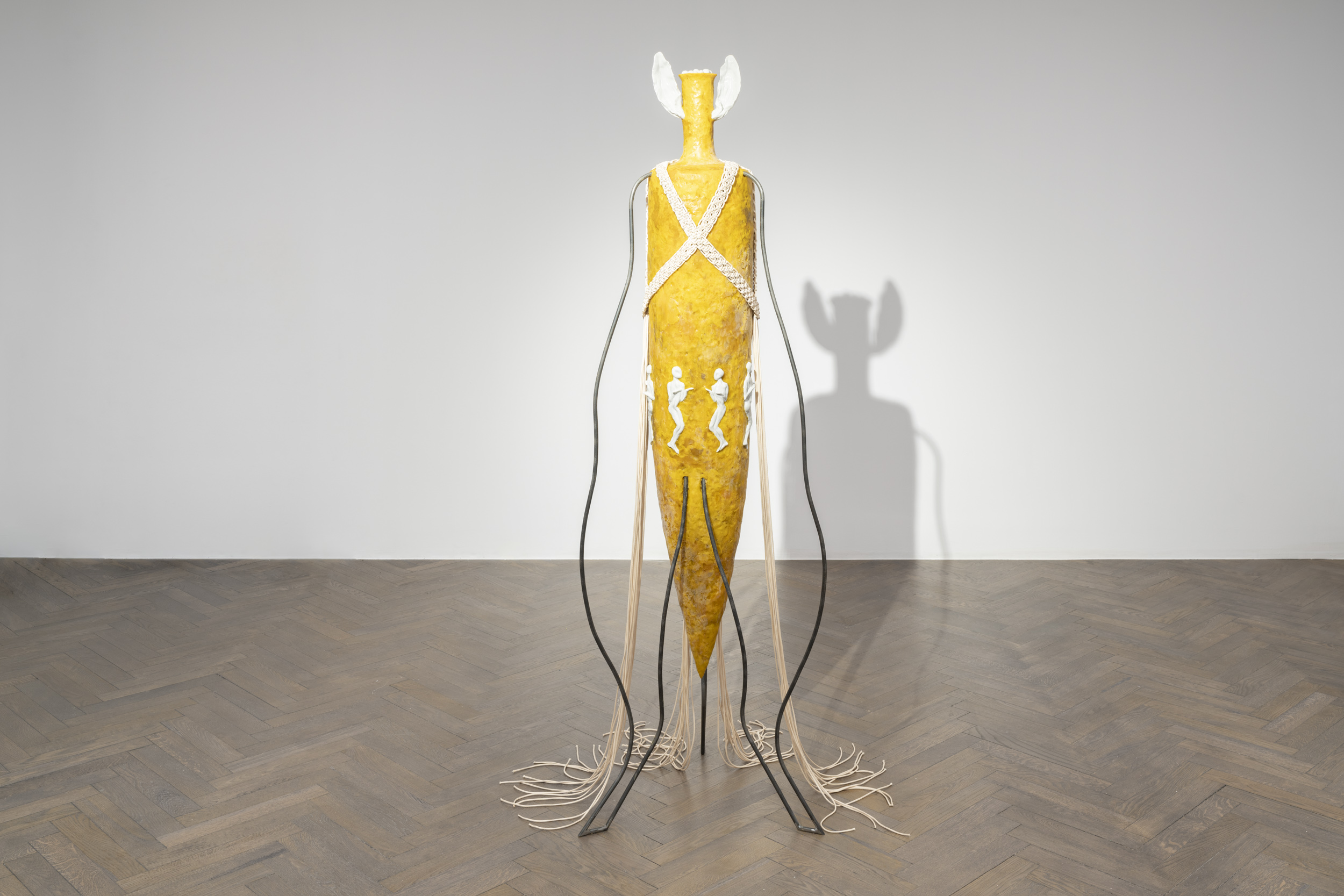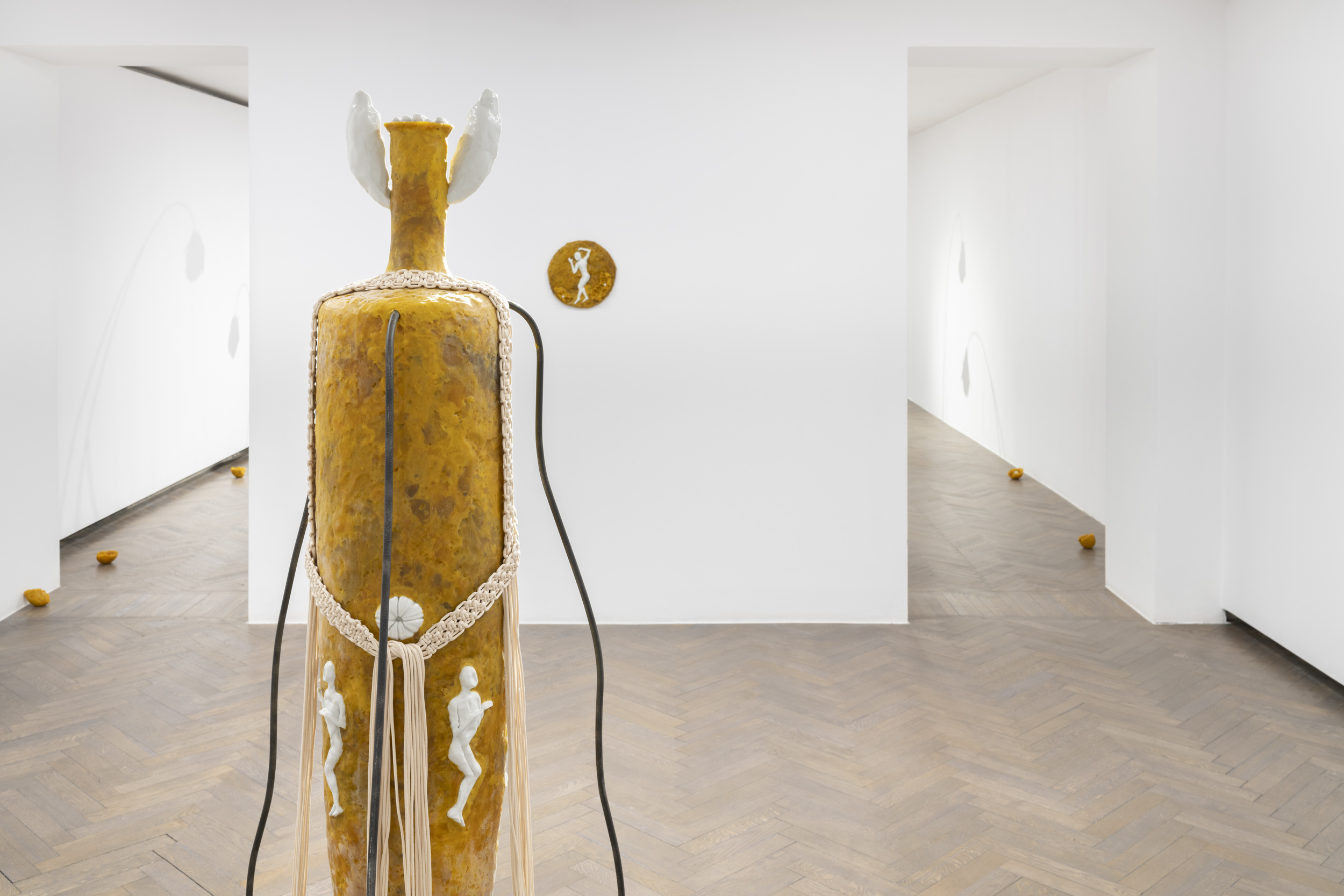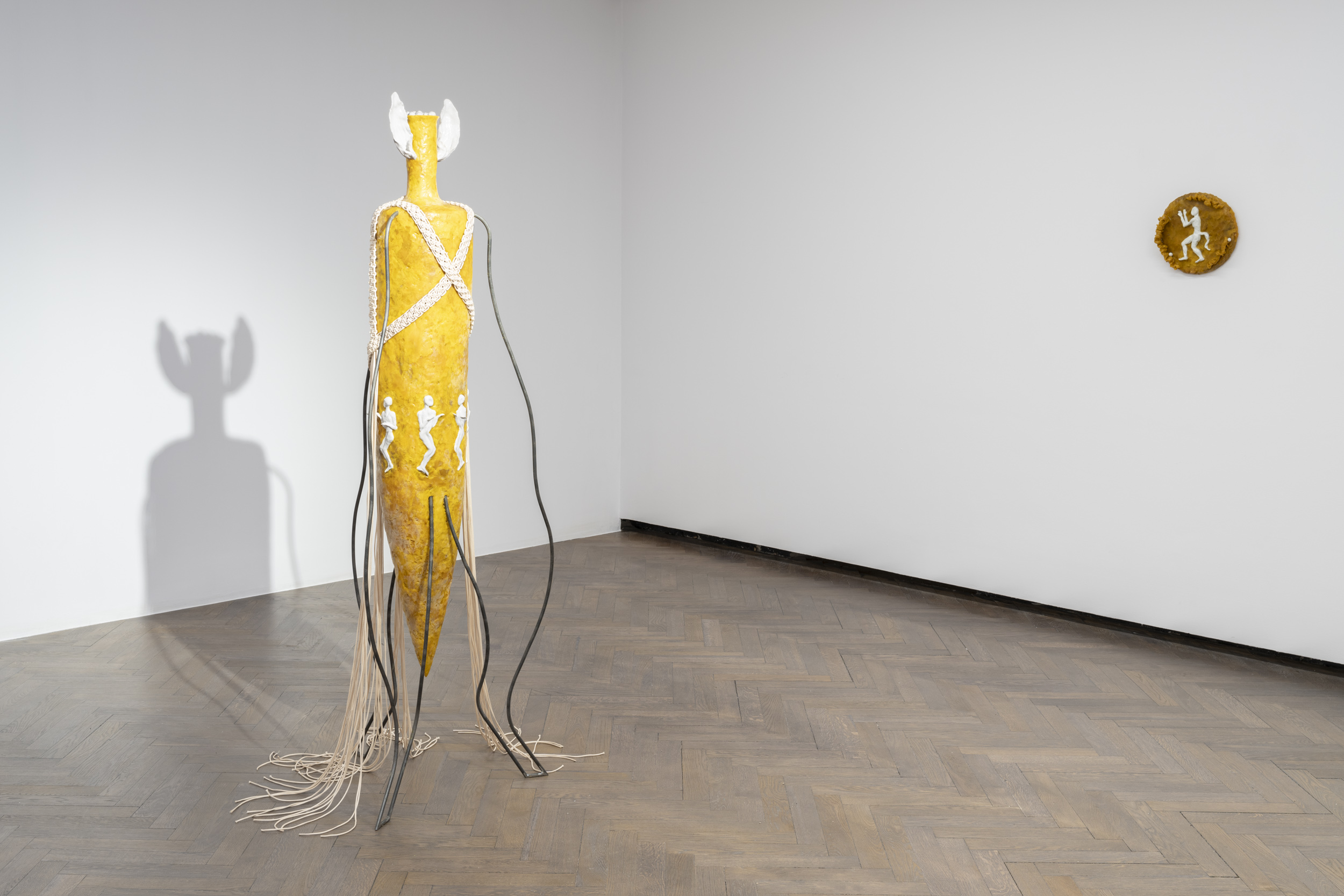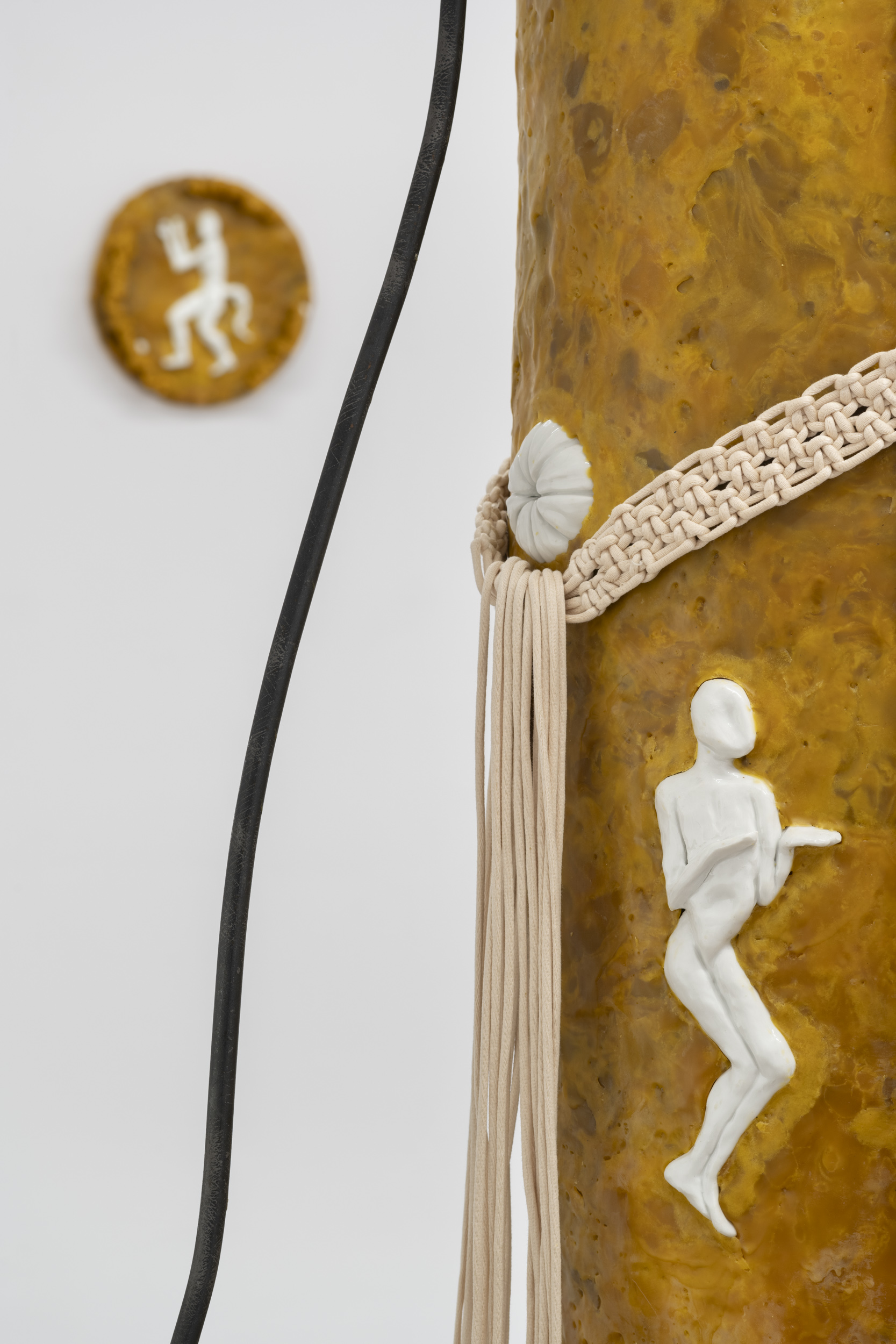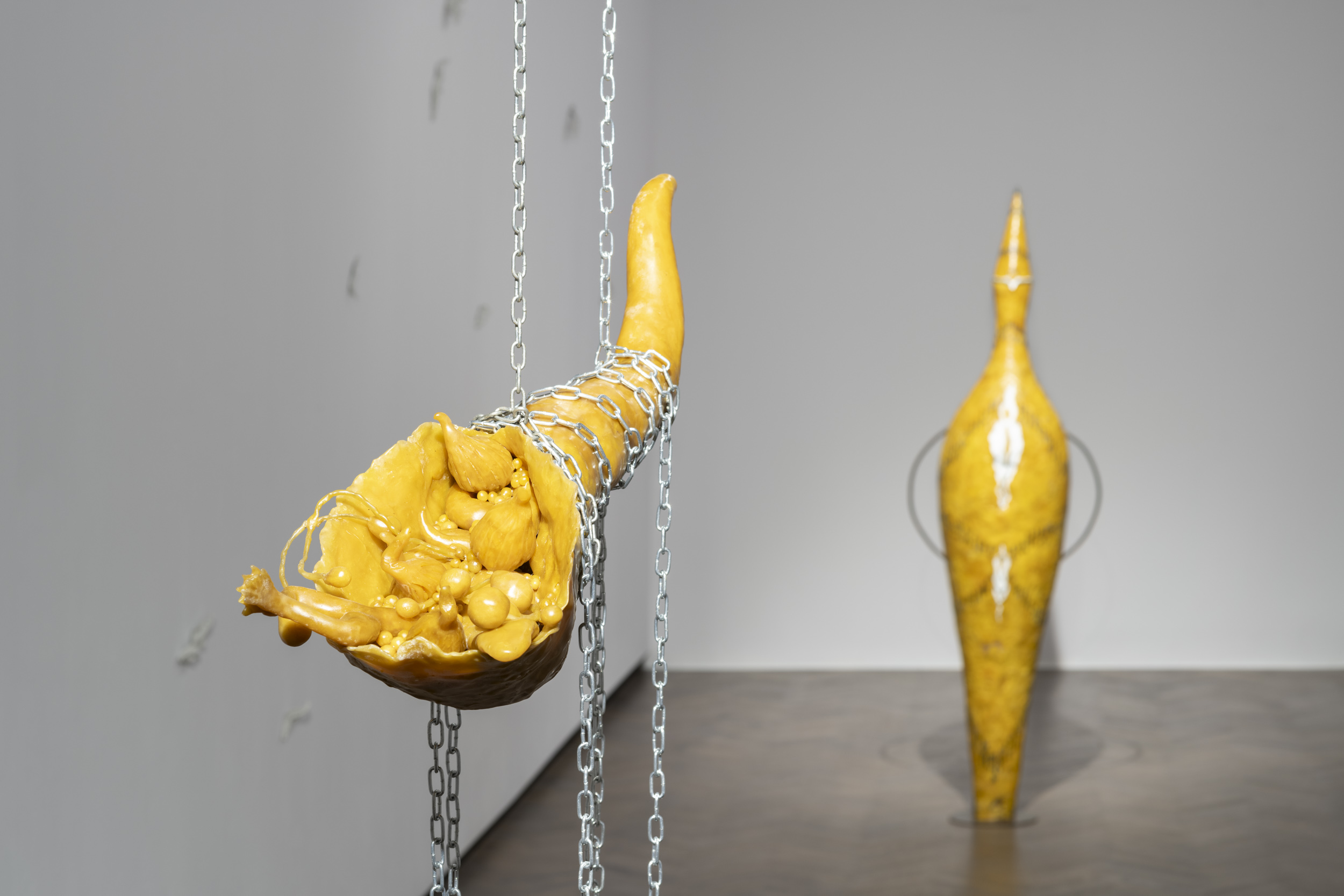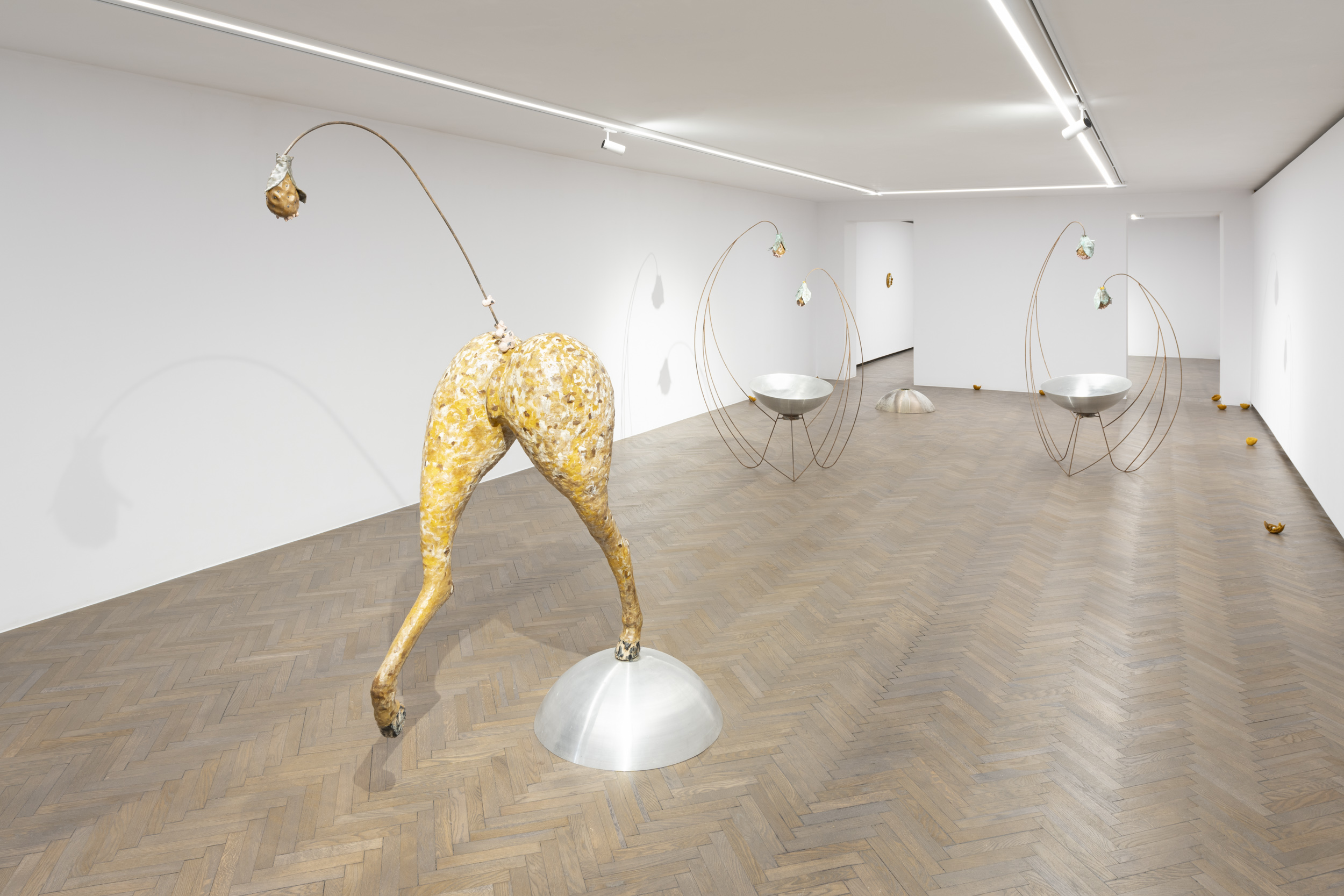gideonhorvath.com
The Whispering Hole
solo exhibition, curated by Katarzyna Różniak-Szabelska in Arsenal Gallery, Bialystok, Poland
10.05-21.07.2024
![]()
Photography: Tytus Szabelski / All images copyright and courtesy of the artists and the gallery
One of the legends of King Midas tells of his closely guarded secret—donkey ears, with which the ruler was punished by the god Apollo. Midas hid them under his headdress, and the shameful secret was known only to his barber. (In another version of this tale—the pre-Islamic legend of King Ossounes of the Yenisei—the confidant was the last surviving barber in the kingdom; all previous ones had been ordered murdered.) Unable to bear the weight of the secret entrusted to him, Midas’ unfortunate barber went to a meadow, dug a hole, whispered the words “the king has donkey ears” into it, and quickly buried it. Some time later, a clump of reeds grew in the place, and whenever the wind moved them they repeated this one phrase. “The king has donkey ears, the king has donkey ears, the king has donkey ears...”. According to some accounts, the coming to light of this information led Midas to commit suicide.
![]()
![]()
![]()
![]()
![]()
In Gideon Horváth’s exhibition, the “whispering hole” of the title becomes a metaphor for the dark secrets and shame that people in heteronormative societies have been forced to live with over the centuries. The Hungarian artist is interested in the complicated life stories of non-heteronormative minorities, which cannot be written into the heroic narratives of the history of emancipation movements. The kind told by Huw Lemmey and Ben Miller in their popular podcast series and book entitled “Bad Gays: A Homosexual History.” As the authors explain (themselves writing from the perspective of white gay men)—“it’s a book about gay men in history whose biographies don’t flatter us.” “liars, the powerful, the criminals and the successful.” Unlike the heroes of the LGBTQ movement, these individuals are rarely remembered as homosexual. However, Lemmey and Miller demonstrate that their sexuality had just as important an impact on their lives as on the lives of those who are remembered positively. The love and desire felt for people of the same sex often became a source of shame and the resulting unethical behavior or crimes, resulting in even more shame. Many suffered deep trauma due to guilt caused by socially unacceptable sexual desires. As the authors argue, while forced by society into ways of life that were impossible for them, they often made strange, “bad” choices. Today it is becoming important to understand the relationship between their desires and actions. Gideon Horvath encourages to confront one’s dark sides and integrate repressed traits, for queer people often the basis of survival strategies. He invites us to whisper our own secrets inside the installation set up in the gallery.
![]()
![]()
![]()
The artist’s main sculptural material is wax, which represents vulnerability. Like the porcelain used more recently in Horváth’s work—wax is both extremely fragile and highly resistant. It symbolizes a state of emotional exposure, which the artist sees not as passive suffering, but as a liberating form of action and emancipation, not based on heroism. In his sculptural installations, Gideon Horváth also intuitively explores the relationship between sensuality, guilt, stigma and shame, often inspired by his own personal stories.
![]()
![]()
![]()
Standing in a corner of the room, the wax-made vase resembles a soft human body. It is covered with black stigmas and topped with a pointed cap [Dunce Cap]. In the 19th century, in European and American schools, undisciplined students or children who were slower learners were shamed by being forced to wear such a headdress. This work was made in 2023, when Gideon Horváth was awarded—the most important award for young Hungarian artists—the Esterhazy Prize. As part of the competition, he was to present Memory That Could Have Been, a sculptural installation dedicated to the history of the city’s non-heteronormative residents at the Ludwig Museum in Budapest. The installation had to appear with a censored concept due to the “Propaganda Law” passed by the government in 2021 and still in force—a law prohibiting the depiction and promotion of diverse gender identities and sexual orientations. As a result of these developments, a new work appeared at the museum in the middle of the installation. The Vase of Shame acted as a coded message there about the shame of taking part in censoring, but also about the shaming the young artist subsequently faced from parts of his community. On the one hand, it is a story about the production of a culture of shame that takes away agency; on the other, about the expectation of heroism from a repressed homosexual artist.
![]()
![]()
![]()
Swaying gently in the main room of the exhibition, Overripe Fruits were based on a much more distant memory of a garden at a vacation home in the Hungarian countryside owned by Gideon Horváth’s family. It had a small orchard with apricot trees next to it. The artist recalls how, as a child, he would get up early in the morning when most of the household was still asleep and sneak out to eat the fruits. Apricots are only perfect for a very brief moment—the ones bought in stores are usually unripe, but it only takes a moment for them to become unfit for consumption already. Gideon constantly monitored the garden and knew in advance which fruits would be perfect in a few days. He remembers that the apricots were heated from the sun’s rays, warm and buzzling, resembling flesh. Putting them in his mouth, the sensation felt when they melted on his tongue, the taste, he recalls as the first such sensual (though not in an erotic way) experience in his life. Perhaps it was somehow related to guilt and shame, because he didn’t want to share the fruits with others—he would get up so early to have them only for himself. Today he believes that eating was a defense mechanism for him at the time. Being overweight—in his experience—allowed him to hide from being sexualized by outside gazes and protected him from normative expectations.
Another story regarding the creation of works depicting overripe fruit took place at the Kiscell Museum, where at the invitation of one of the curators, Viktória Oth the artist was to make a sculpture in the surrounding park. At his request, the museum staff searched, unfortunately without success, for representations of non-heteronormativity in their collection. It wasn’t until Horváth asked museum staff for works by Lajos Barta, a Hungarian-Jewish homosexual sculptor who worked during World War II, that one of them reached out for a drawing by another artist, Endre Rozsdás—privately Barta’s partner. The drawing depicted the head of a horse placed on a female bust. The thought of non-heteronormative loves unrecognized in art history aroused the artist’s frustration. Its symbol became overripe fruit, wasting away on the tree and giving no pleasure, although it could be picked in the first place. As the artist says, the whole society could have benefited from these works and stories, felt the pleasure they give, but it was decided not to do so. In the park at the Kiscell Museum a similar sculpture was placed, depicting a tree with three overripe fruits. They look as if they are about to fall straight into the bowls set beneath them and spread out, as in the work Served Fruit, showing the insides of their unconsumed bodies.
The very material in which Gideon Horvath works is also a unique representation of corporeality. Because of its softness and warm color, beeswax resembles human flesh, but comes from a different animal. It is, in the artist’s words, a “visceral” material, because it is created in the bee’s lower abdomen. Very intimate and sensual. In the wax-based creative process, a unique connection is created between the artist and the creatures from which the material comes. The wax itself, according to Horvath, is a kind of portrait of this “visceral” quality created in the bee’s body. This access to inner corporeality seems to point to Horvath’s desired state of physical and emotional exposure, representing a form of emancipation other than heroism as traditionally understood. The fascination with corporeality, understood also as the interiors of various bodies, recurs in the subsequent works presented in the exhibition: the interiors of decaying fruits, vases (from antiquity imitating human bodies) or abundance, pouring out of an ancient horn like, to quote the artist, “never-ending bodily fluids.”
![]()
![]()
![]()
The cornucopia in Roman mythology is an attribute of the goddess Ops—the matron of wealth, abundance and prosperity. Associated with her name is the English word opulence [wealth, splendor, luxury] evoking a camp, queer aesthetic. The phrase Opulence, you own everything! became an internet meme a few years ago thanks to RuPaul’s Drag Race program, but originally came from the cult documentary Paris is Burning (1990), depicting the ballroom culture of New York City in the 1980s and the lives of the African-American, Latino, gay and transgender communities that comprised it. These groups, themselves on the economic and social margins, mimic the glamour and luxurious lifestyles of the white upper classes in an exaggerated, staggeringly rich way. The horn symbolizes the abundance of survival tactics, oozing opulence as rich as if it would never end. In this work, Gideon Horváth first combined queer culture with mythological narratives, giving rise to subsequent works creating his fantastic and equally rich inner world.
Inspired by queer theory, Gideon Horváth’s exhibition creates a space full of mythical references for sensual and intuitive modes of experience. The artist’s private mythologies are mixed here with well-known Greek and Roman myths, historical customs and quotations from the queer texts of culture. In mythical creatures, the artist seems to see the possibility of freeing human bodies from standardized norms. According to him, anatomy is a normative way of describing bodies, setting oppressive standards. His work, meanwhile, allows for fantastic transformations involving donkey ears and tails growing out of human bodies.
The mythological figure of the faun occupies a special place in his work. In his interpretation, the faun becomes a marginalized figure, exiled because of his queerness. The faun hides, adapting to the circumstances. Like the community of the New York ballroom scene, he can imitate rich, white people and blend in. He can take on their forms, but he can also stand out. Faun, whom the artist often impersonates during performances, begins a process of emancipation in which his vulnerability becomes a force. The walls of one of the exhibition’s rooms are filled with ceramic figures of fauns, who are part human, part goat. The artist is attracted to this hybridity. In pursuit of it, he sometimes dismembers the figures into separate body parts.
![]()
The monumental leg—a reference to the hybrid forms of mythical bodies—is inspired by old, retired police horses that Horvath used to meet regularly, running in the park of Schloss Solitude. Their ankles, after years of working for an oppressive system, were very low, very close to the ground. Despite their powerful musculature, horses are very sensitive, and the most fragile part of their bodies are their legs. Injuring them often means death. The artist is interested in how oppressive systems exploit the vulnerability of minority groups, but also how sensitivity and fragility [vulnerability] can be a strength, have the power of emancipation. The sculpture combines unique vulnerability with the majestic strength of the animal. Balancing between these extremes, it stands on an impossible to balance surface.
In another part of the exhibition, porcelain feathers hang on the walls—on the one hand, accompanied by the Vase of Shame, the fallen feathers symbolize memories of failures, which the artist would like to celebrate, recognize their value, instead of hiding and being ashamed of them. On the other hand—feathers also refer to fragmented corporeality, they are elements growing out of bodies, simultaneously being and not being part of them. Like the single leg of a horse—they seem ready to merge with other bodies into any new configuration.
There is in these elements an assumption of the existence of interconnections between different bodies. The place of rigidly defined identities is taken by a vision of interconnectedness, overlapping entities, destabilizing identity categories and blurring the boundaries between human and non-human bodies. It’s a vision that allows us to build alliances and coalition politics that transcend our understanding of identity. Containing the elusive potential for bonds between separate bodies and identities, depicted using fluid, ambivalent and mutable beeswax. A material characterized by a constant “becoming” rather than normative “being.” And therefore called queer by the artist.
Katarzyna Różniak-Szabelska
Photo documentation of the performance at the opening:
![]()
![]()
![]()
![]()
![]()
![]()
![]()
![]()
![]()
![]()

![]()
![]()
![]()
![]()
![]()
![]()
![]()
![]()
![]()
![]()
![]()
![]()
![]()
![]()
![]()
![]()
![]()
![]()



